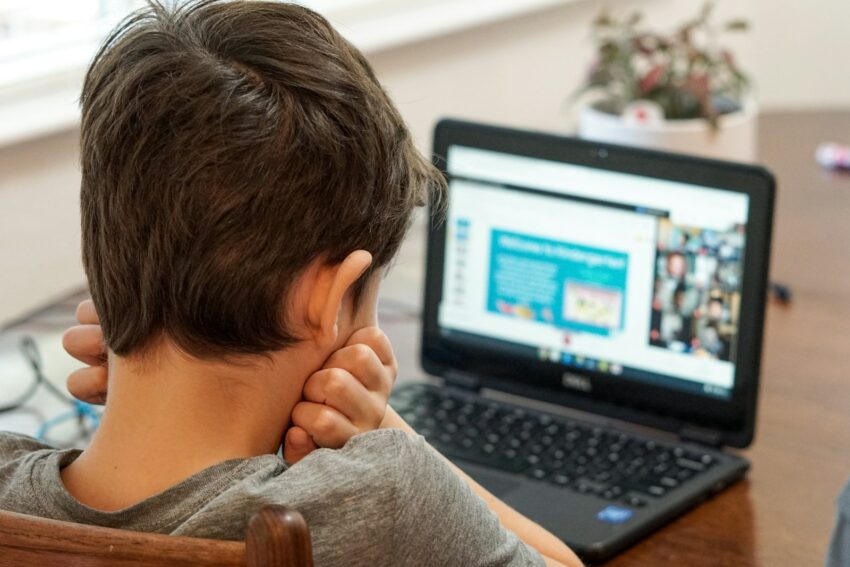Online courses for homeschoolers can be amazing! Not just for your homeschoolers but for you as well. What could you do if you didn’t have to teach biology for your older elementary or middle school kids? I could make supper… So using online courses in our homeschool just makes sense.

This post contains affiliate links, see my disclosure policy for more information.
Benefits of Online Courses
I have begun to love using digital homeschool curriculum over the past few years. We aren’t limited to only using online courses but it has been a great addition to our homeschool. I want to share those benefits with you.
Cost-effective.
No storage!
More variety.
Accessible from anywhere!
Accessibility is important. This one can be really important. If you are road schooling or need to travel for work then your kids are able to log on wherever they are for their lessons. You don’t have to haul curriculum along with you to keep on schedule.
Finding Online Course for Homeschoolers
The online class options for homeschooling have grown exponentially over the past few years. We homeschool moms no longer need to wonder if there’s a course that will work for our kids. Now, we need to decide which course will work for our kids.
Think about all the things you need to consider when looking for an online course.
Things you’ll need to keep in mind are:
- What subjects does the course cover?
- What grade level is the course intended for?
- Is this an all-in-one course or can you choose individual courses for a more flexible education?
- Are classes live or self-paced (you can take at anytime)?
- How much does the course cost?
- How long do you have access?

Online Courses for Homeschoolers
- Self-Paced Online ASL Classes for Elementary
- Human Biology Curriculum
- Online Learning Platforms for Homeschooling
- Learning with Online Unit Studies for Homeschoolers
- BookShark Virtual is Here!
- MYTEK LAB: Technology Education for Homeschoolers
- Middle School Homeschool Chemistry Curriculum – Fascinating Education
- Teaching Textbooks 4.0 – Math Anywhere We Go
- Online Typing Practice With KidzType
- Smartick Math – Having Fun with Math
- Educational and Fun Screen Time with Reading Eggs
- Mastering Multiplication with Times Tales
Making Online Courses Work for Your Homeschool
Online courses can be an incredible tool for homeschool families, but only if they’re used intentionally. It’s easy to get caught up in the promise of self-paced learning or expert-led classes, only to discover that managing technology, pacing, and motivation can be a challenge. In this supplement, we’ll explore how to make online courses a seamless, effective part of your homeschool routine.

Assessing Readiness Before You Begin
Before enrolling your child in an online course, take a step back and evaluate your setup and your child’s readiness. Reliable internet, a working computer or tablet, and a quiet, comfortable workspace are must-haves.
Next, think about your child’s learning style and level of independence. Some students thrive in self-paced environments, while others need structure and accountability. You’ll also want to consider your own role—will you serve as a coach, tech helper, or hands-on supervisor?
Finally, look at your weekly schedule. If your homeschool style is relaxed or child-led, live online classes with strict deadlines might cause stress. For some families, starting with just one or two online courses helps everyone adjust before adding more.
Blending Online and Offline Learning
Online courses shouldn’t completely replace traditional learning. The best results come when you use them alongside offline reinforcement and family discussions.
After each lesson, encourage your child to write a short summary, complete a hands-on activity, or teach the concept back to you. Plan regular review sessions to check progress, discuss confusing topics, and celebrate accomplishments.
If your student’s course includes projects, find ways to connect those projects to real life. For example, a science lesson might inspire a backyard experiment, while a history unit could become a family documentary night. These moments deepen understanding and keep learning fun.

Avoiding Common Pitfalls
Even great online courses can present challenges. The most common issue is overwhelm—students can easily fall behind or lose motivation. To prevent burnout, don’t overload your schedule and allow flexible days for catch-up or review.
Technical problems happen, too. Have a backup plan, like downloading lesson notes or keeping printed copies when possible. And don’t assume your child will stay accountable without guidance. Setting clear milestones and regular check-ins keeps things on track.
One more big one: passive learning. If your child is just watching videos without engaging, the material won’t stick. Turn lessons into discussions, journaling prompts, or creative projects to encourage active participation.
Choosing the Right Online Course
When evaluating online courses, go beyond the basics of cost and subject. Look for instructors who provide real support and feedback. A great course includes clear communication channels, active forums, and a responsive help system.
Consider how the material is presented—does it include captions, transcripts, or downloadable resources? Variety in teaching methods helps reach different learning styles. Courses that include built-in quizzes, projects, or feedback opportunities tend to produce stronger engagement and retention.
Also, check for alignment with your homeschooling goals. Does the course meet your state’s requirements, or provide a certificate of completion? If your child may transfer back to traditional schooling later, this can be important.
Finally, community matters. A course that includes group projects or discussion boards can help homeschooled students feel connected to peers who share their interests.
Thinking Beyond the Usual Subjects
There are more online learning options today than ever before. Beyond core subjects like math and science, you can find incredible classes in creative and practical fields too.
Consider letting your child explore niche interests like American Sign Language, Japanese, or Latin. Coding and digital design courses can spark lifelong skills, while entrepreneurship or financial literacy classes teach valuable real-world lessons.
Don’t overlook hands-on options either—there are online courses for cooking, sewing, home repair, and even mindfulness. Mixing fun electives with academic courses keeps homeschool life balanced and motivating.
Saving Money on Online Courses
Online education doesn’t have to be expensive. Many providers offer free trials, sibling discounts, or bundle deals for multiple classes. Before enrolling, always read the fine print—some programs charge extra for textbooks, grading, or materials.
You can also mix free and paid resources. Use high-quality free options like Khan Academy or CK-12 for core subjects, and reserve your budget for advanced or specialized classes.
If your homeschool community has co-ops, consider sharing course access or buying group licenses when allowed. And for courses that provide permanent access, reuse them for younger siblings in future years.
Building a Plan That Fits Your Family
The key to success with online courses is flexibility. Build a rhythm that includes structured study times but also room for exploration and rest. A simple daily routine might include watching a lesson, doing hands-on practice, discussing what was learned, and setting goals for the next day.
Check in weekly to talk about progress, challenges, and what your child enjoyed most. This keeps learning personal and encourages responsibility. Over time, students become more independent and confident in managing their own learning.
Encouraging Reflection and Growth
One of the biggest benefits of online learning is teaching kids to manage themselves. Encourage your child to keep a short learning journal, noting what worked well, what felt challenging, and how they plan to improve next time.
Celebrate progress, not perfection. Missed quizzes or tough topics aren’t failures—they’re opportunities to learn perseverance and problem-solving.
At the end of each course, sit down together to review what went well and what could be improved. These reflections will help you choose even better courses next time and build a stronger, more personalized homeschool experience.
Online courses open up a world of opportunity for homeschoolers.
They can connect your child to passionate instructors, fascinating subjects, and new ways of thinking—all from home. The trick is finding the right balance between online structure and offline creativity.
Start small, keep it flexible, and focus on engagement and growth over perfection. With the right approach, online learning can be one of the most rewarding parts of your homeschool journey.
